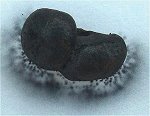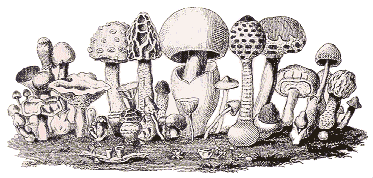Fungalpunk Dave had reported seeing a proliferation of Daldinia fissa on burnt gorse at Moore Nature Reserve during a foray on 19th September 2010. I led a beginner’s foray in early October and had soon located the burnt gorse site. The branches on every bush that had been burnt were covered in the stromata of D. fissa. One of the beginners enquired how the fungus had spread so rapidly could it have been lying dormant in the gorse prior to the fire. Another question was how D. fissa could grow on burnt wood.
 Terence Ingold back in 1946 suggested that D. concentrica is xerophytic (adapted to arid conditions) by virtue of the water reserve in the stroma allowing long-continued spore discharge under extremely dry conditions. The gel part of the concentric rings of Daldinia stromata are believed to be the key to its xerophytic habit. Thus it is perhaps not surprising that some species of Daldinia are capable of sustained fruiting on burnt wood.
Terence Ingold back in 1946 suggested that D. concentrica is xerophytic (adapted to arid conditions) by virtue of the water reserve in the stroma allowing long-continued spore discharge under extremely dry conditions. The gel part of the concentric rings of Daldinia stromata are believed to be the key to its xerophytic habit. Thus it is perhaps not surprising that some species of Daldinia are capable of sustained fruiting on burnt wood.
In northern Europe at least five Daldinia species are recognised: D. concentrica, D. fissa, D. grandis, D. loculata and D. petriniae and three are found exclusively on burnt wood: D. fissa, D. grandis and D. loculata (Johannesson et al., 2000). Species of Daldinia and some other members of the Xylariaceae are suggested to be endophytes, organisms that live inside plant tissues for at least part of their life cycle without causing any disease symptoms in the host (Whalley, 1996) until wood decay is triggered by drying out e.g. due to a forest fire (Johannesson et al. 2000). The widespread presence of such latent fungi has been demonstrated in the laboratory where lengths of what had been healthy twigs, branches and trunks were dried under controlled conditions (Boddy, 1994).
Hanna Johannesson (2000) has carried out a detailed study on the genetics of Daldinia loculata whose stromata are confined to the burned wood of deciduous trees and proposed a tentative life cycle involving periodic forest fires and fungivorous insects as a vector for spreading asexual conidia between trees thereby initiating the sexual reproduction of the fungus.
 I brought a detached stroma of D. fissa home with me and placed it on a piece of white card. After only one hour a large deposit of ascospores had collected on the card. In studies carried out by Ingold (1956) he suggested that both the considerable width of a spore deposit obtained from isolated stroma of Daldinia and its zoning are associated with the discharge of projectiles ranging in size from individual spores to groups of eight (i.e. all the eight spores contained in a single ascus).
I brought a detached stroma of D. fissa home with me and placed it on a piece of white card. After only one hour a large deposit of ascospores had collected on the card. In studies carried out by Ingold (1956) he suggested that both the considerable width of a spore deposit obtained from isolated stroma of Daldinia and its zoning are associated with the discharge of projectiles ranging in size from individual spores to groups of eight (i.e. all the eight spores contained in a single ascus).
References
Boddy L. 1994. Latent decay fungi: The hidden foe? Arboricultural Journal, 18 (2): 113–135.
Ingold, C.T., 1946. Spore discharge in Daldinia concentrica. Transactions of the British Mycological Society, Vol 29, Issue 1-2: 43-51.
Ingold C.T., 1956. The spore deposit of Daldinia, Transactions of the British Mycological Society, Vol 39, Issue 3: 378-380.
Johannesson H., 2000. Ecology of Daldinia spp. with Special Emphasis on Daldinia loculata. Doctoral thesis, Swedish University of Agricultural Sciences, Uppsala.
Johannesson H, Laessøe T, Stenlid J. 2000. Molecular and morphological investigation of the genus Daldinia in Northern Europe. Mycological Research, 104 (3): 275–280.
Whalley, A.J.S., 1996. The Xylariaceous way of life. Mycological Research, 100: 897-922.
